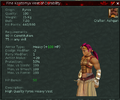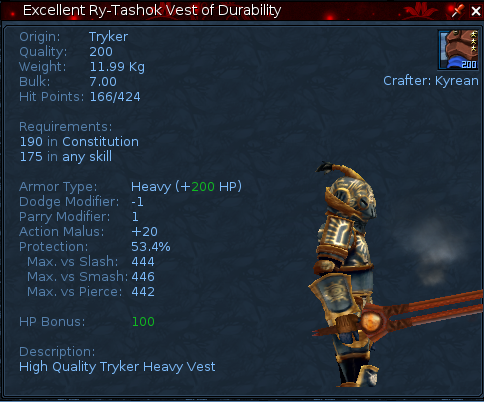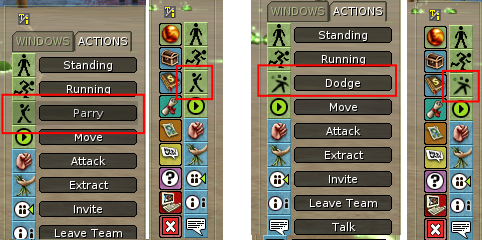Fairhaven “Little Ones” Market is an event, organised by the “Le Marché des Petits” collective, which takes place every Jena year, during the 3rd CA, on Fairhaven beach, northeast of the main entrance.
To forum announcement: Forums » EVENTS » [For All] Fairhaven Little ones Market
transcript from An-thik’al course, Tria, Medis 9, 3e CA 2605 (19th October 2019) - go to the Market.
We could discuss indefinitely the cut, the color, the style... But, if you look closer, Atysian outfits fall into 3 categories:
- Light armor
- Medium armor
- Heavy armor
Contents
Armor for what?
Which armor to choose and how to distinguish them?
The easiest way is to select a part from your inventory or equipment tab and click on "info" in the pop-up menu that appears.
Here are the important features to consider:
Absorption of physical damage
Armor is primarily used to protect you. It protects you from physical attacks from an enemy, but not magical attacks!
This protection is defined by the characteristic "Protection factor" in percentage. An armor with a protection factor of 30% can therefore, in theory, reduce the physical damage of an enemy by 30%.
It is therefore necessary, a priori, to favour armour with a high percentage of protection.
In addition, physical attacks can be of three types:
- Sharp (ex PVE: clopper / ex. PVP: sword)
- Perforating (e. g. PVE: kirosta / e. g. PVP: spade)
- Blunt (e. g. PVE : bodoc / e. g. PVP : mass)
On your armor piece you will find 3 values of maximum damage absorption, one for each type of damage.
It is necessary to combine both protection factor (in %) and absorption (in point), taking the lower of the two results.
The maximum blunt damage absorption rate is 446 on my armor: I can reduce the attack by 446 points maximum.
But the protection factor of my armor is 53.4%, or 324 points: so I reduce the attack by 324 points. I therefore collect 283 damage points.
These three absorption rates are related to the quality of my armor. The higher the quality of the armor, the higher the numbers.
It is necessary to privilege an armor with the highest quality.
The percentage of protection (excluding boost) changes according to the type of armor:
- 45% ~ 55% for heavy armors
- 30% ~ 45% for medium armor
- 10% ~ 25% for light armors
Action malus
From this perspective, you might think the best armor is heavy armor. That's forgetting the action penalty.
This malus increases for each action the consumption of life, sap, stamina and focus. For a mage, it also reduces the range of a spell.
- Light armor: no malus.
- Medium armor: 5% malus per piece: total 25% for a complete armor set.
- Heavy armor: 20% malus per piece: total 120% malus for a complete armor set.
Armor that minimizes the malus of action should be preferred.
The malus of action is in opposition to the protection factor. The choice of armor will depend on how you fight.
- Heavy armor that favors the protection factor for close combat, e. g. tank.
- Light armor that reduces the malus of action for a mage who attacks from a distance and never goes close (e. g. group with tank)
- Medium armor can be a good compromise depending on the circumstances: second tank, shooting weapon, hand to hand mage....
A harvester will prefer light armor to minimize his consumption in focus.
The choice between light, medium or heavy armor depends on what you want to promote: minimize the "malus of action" or maximize the "protection factor".
Life Bonus and Generic Bonus
Armor parts add a life bonus depending on their type:
- light armor: 0
- medium armor: quality/2
- heavy armor: quality
In addition to this automatic life bonus, the craftsman can when making an armor element add a generic life, focus, stamina or sap bonus of a maximum value of "quality/2".
In general, the generic "life" bonus is a good choice. Otherwise:
- harvesters will prefer a focus bonus.
- the mages will prefer a sap bonus.
- melee fighters will prefer an endurance bonus.
You can also mix these bonuses generally with a life part.
Defense Mode
There are 2 modes of defence: parry or dodge.
You can select the mode from your options bar.
You will find your dodge or parry values in the identity screen, press P.
Your personal parry or dodge value changes according to your level:
Dodge = your maximum level in magic or melee, or your maximum level/2 in drilling or crafts.
Parry = your maximum level in melee with the equipped weapon.
We are always looking to maximize this value.
The choice of a defense mode, parry or dodge, therefore depends on your level and the weapon and armor you're wearing.
It should be noted that each piece of armor brings a parry or dodge bonus as follows:
- Light Armor - Dodge: 1 to 2 / Parry: 0 to 1
- Medium armor - Dodge: -1 to 1 / Parry: 0 to 2
- Heavy armor - Dodge: -3 to 0 / Parry: 0 to 3
We try to maximize one of the two bonuses, and most often we will talk:
- full dodge light armor: 2 x 5 pieces = +10 dodge in addition to your basic dodge
- full parade heavy armor: 3 x 6 pieces = +18 parry in addition to your basic parry
Max quality I can wear
Finally, how do I know if I can wear an armor piece?
If the armor is grayed out in the inventory or a purchase or exchange interface, you do not have the required characteristics, namely:
- Light armor: maximum level + 25.
- Medium armor: constitution x 1.5.
- Heavy armor: constitution + 10.
see https://app.ryzom.com/app_forum/index.php?page=post%2Fview%2F197776&lang=en





